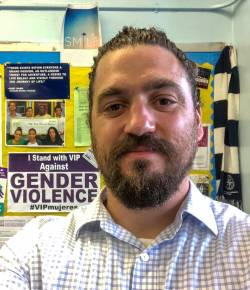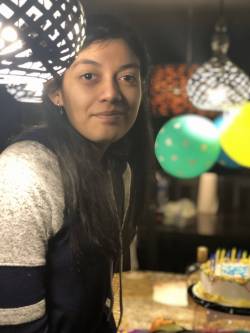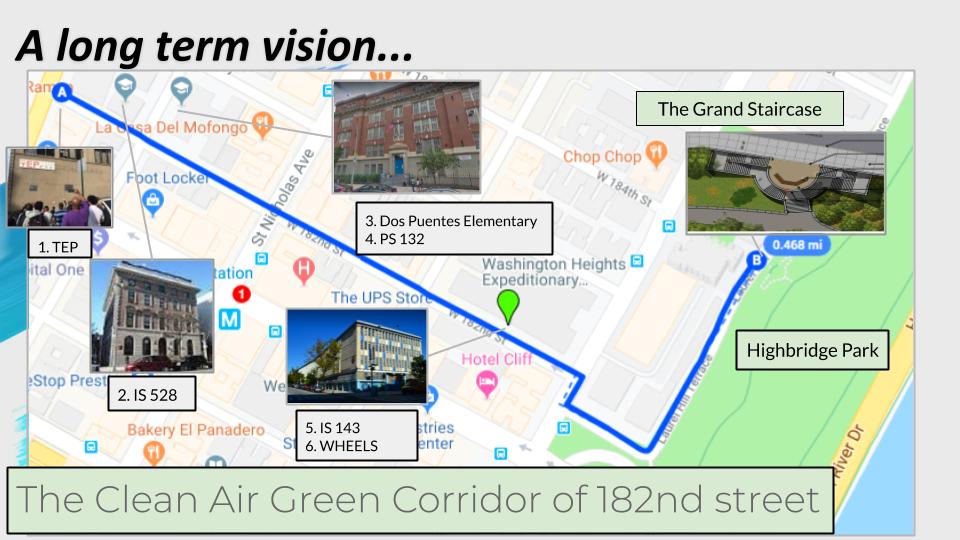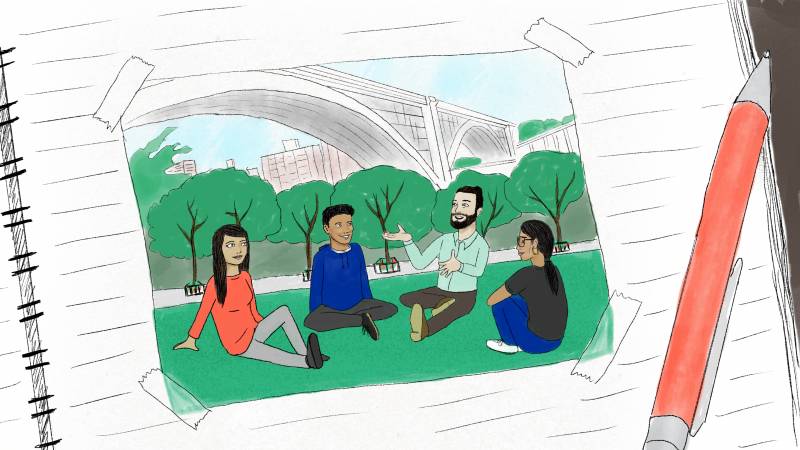Teachers submitted resources and lesson plans relevant to the times and students’ experiences. There were resources on understanding the virus and how to interpret pandemic data. Coronavirus brought renewed attention to systemic racism because of the way Black, Indigenous and Latino people died from the infection at disproportionate rates. The Black Lives Matter protests that emerged from the killing of George Floyd by a white police officer in Minneapolis also amplified the need for systemic change. Mental health was a top priority as students were seeing trauma unfold around them.
Pivoting to Student Pandemic Journal
Before the coronavirus outbreak, keeping a journal wasn’t exactly part of the curriculum for English teacher Anthony Voulgarides. He submitted a pandemic journal lesson plan to “Connecting Across the Distance” and it proved to be an essential way to help his students stay connected to one another and to him during the crisis. Every week, students published journal entries to a document called “Unprecedented Times.”
 “As a teacher, I feel like it’s my job to try to understand what’s most relevant for our students right now, in this moment, and try to tap into that,” said Voulgarides, who teaches at Washington Heights Expeditionary Learning School in New York City. At the time, the city was a hotspot for coronavirus infections and his students’ families were not spared. Some had to quarantine at home with an infected family member, others had a parent on a ventilator for a month. Senior Diane Arevalo’s uncle died after contracting the virus.
“As a teacher, I feel like it’s my job to try to understand what’s most relevant for our students right now, in this moment, and try to tap into that,” said Voulgarides, who teaches at Washington Heights Expeditionary Learning School in New York City. At the time, the city was a hotspot for coronavirus infections and his students’ families were not spared. Some had to quarantine at home with an infected family member, others had a parent on a ventilator for a month. Senior Diane Arevalo’s uncle died after contracting the virus.
 “My family, we call him ‘The Newspaper’ because, you know, he knew everybody and everyone knew about him,” she said of her uncle. “And he’d go through the whole neighborhood in the morning. He’ll wake up at six o’clock in the morning, go to his mom’s house, give her food, and then he would go back home and take care of his kids.”
“My family, we call him ‘The Newspaper’ because, you know, he knew everybody and everyone knew about him,” she said of her uncle. “And he’d go through the whole neighborhood in the morning. He’ll wake up at six o’clock in the morning, go to his mom’s house, give her food, and then he would go back home and take care of his kids.”
Safety measures meant family members were physically cut off from patients in hospitals and loved ones at funerals. Arevalo, who didn’t get to say goodbye to her uncle or send him a final message, decided to write him a letter as part of her journal assignment. Last spring, she wrote:
When I told you I got into Brandeis, the first thing you did was come over and bring me a cake. That was the last time I got to see you, Tío. I want to say it’s unfair that you were taken already, but I know you were in pain and now you are better alongside Tía now. Your kids were raised as if they were my siblings. I gained two older brothers and an amazing big sister through you. All I want is that, with your loss, it can bring us all even closer. Thank you for the love, laughter, and support you have given all of us every day.
The journal entries took many forms. Some students submitted drawings. Some shared what they were watching on Netflix. Someone wrote an essay on shelter-in-place from the perspective of a house cat. Others got really vulnerable and shared details they normally keep to themselves.
 “Even if I FaceTime my friends for hours, you know, we’re not just sitting talking about our feelings for hours,” said senior Yohely Comprés. “And so I read their journal for English class and I learned more than I learned in the FaceTime call.”
“Even if I FaceTime my friends for hours, you know, we’re not just sitting talking about our feelings for hours,” said senior Yohely Comprés. “And so I read their journal for English class and I learned more than I learned in the FaceTime call.”
Comprés’s journal entry was about how she had to stay distant from her family members inside their home. In March, she wrote:
Today, my mom didn’t wake up feeling so good. I haven’t touched her warm skin since Friday and I haven’t been able to cuddle her in the mornings either. In order to see her I have to FaceTime her or open the bedroom door just enough so I can peek. I got yelled at by my aunt for opening the door without a mask. I just wanted her to see that I was awake. We’re now waiting for the test results and it’s haunting me thinking about it. Tía tested positive last week. I hope mom doesn’t.
Moments after publishing to the class journal website, Yohely received a text message from a worried Mr. Voulgarides. He was checking in on her after reading her journal entry. He offered to bring groceries to her home and let her know she can reach out to him if she needed anything.
 Senior Julio Jimenez’s father caught coronavirus and spent a month in the intensive care unit. The family could only see him through a phone connection. Suddenly, Jimenez was thrust into the position of medical translator for his family while being strong for his mother and siblings. As the eldest son, he was now preparing to be the head of the household and thinking differently about his future. Everyday high school activities and starting college felt more distant when his family needed him most.
Senior Julio Jimenez’s father caught coronavirus and spent a month in the intensive care unit. The family could only see him through a phone connection. Suddenly, Jimenez was thrust into the position of medical translator for his family while being strong for his mother and siblings. As the eldest son, he was now preparing to be the head of the household and thinking differently about his future. Everyday high school activities and starting college felt more distant when his family needed him most.
“That took a big toll out of me, like, every day,” he said. Before the pandemic, Julio said writing wasn’t exactly his favorite thing to do at school, but the journal turned out to be a way for him to organize his emotions, calm himself down and focus on building emotional strength for his family.
“It has helped me out of writing it down,” he said. “Getting my emotions on paper – that helped me out. You know, it built some stamina in me to get on with my day.”
Typically, writing a journal entry is a private activity. But publishing to a class website for trusted classmates and teachers who have spent years relationship-building helped create an opening for help. It also strengthened the community.
“The fact that those kids were comfortable sharing those journals with one another says a lot about what the teacher did beforehand,” said Tia Madkins, Assistant Professor in the Department of Curriculum and Instruction at the University of Texas at Austin.
Culturally Relevant Teaching and Trust
Teachers at WHEELS spend a lot of time on activities that are outside the more traditional curricula and it’s proven to be a success. WHEELS is part of the EL Education network and an Outward Bound School. Core to the school is creating authentic learning experiences for students, some of which is grounded in the three tenets of culturally relevant teaching: academic success, cultural competence and critical consciousness. The three pillars of CRT were developed by Gloria Ladson-Billings after observing teachers who taught African-American students successfully.
“Every classroom has culture,” said professor Felicia Moore Mensah of Teachers College Columbia University who researches CRT in science education.
“What teachers have to realize is that [culture is] there and it’s present, but how do you make it much more part of the process of learning when you have a classroom that is full of African-American, Latinx children or children with racial, ethnic, linguistic diversity within the classroom?” CRT can help address some of the inequities created by schooling that centers a white, middle-class worldview, which is important to address when more than half of students in public schools are kids of color.
“It does take an extra effort for a lot of white teachers to be able to do this, to be able to focus in on who the students are, bringing them in and asking about aspects of their life as part of the curriculum because our curriculum is not written this particular way.”
For WHEELS students like Diane Arevalo, cultural competence can look like talking about the differences between Ecuadorian and Dominican cultures, while knowing how to write a professional email to teachers. It also means having the critical consciousness to advocate for the change she wants to see in her community.
“It’s not fair to me, it’s not fair to my brother, to my family, to the people that live here that we’re stuck in the middle of a highway next to the George Washington Bridge, that we’re stuck with all this pollution,” said Arevalo of her neighborhood.
Diane and her classmates formed a group to address local environmental issues. The group looked specifically at the health of trees in their neighborhood. The students noticed that in other neighborhoods, trees looked nicer and were protected at the roots by tree guards.

“It’s kind of sad because our tree guards are destroyed,” said Arevalo. “We don’t even have them. And they’re very full of cigarette butts, needles and needle caps. And it’s kind of sad seeing that because we have to go through that every day to go to school.”
The students attended community board meetings to advocate for a Clean Air/Green Corridor. They also applied for grants from local organizations, which is not uncommon for WHEELS students who are passionate about causes relevant to their lives. They succeeded and recently received funding for new tree guards in their neighborhoods.
The school also goes to great lengths to value students’ cultural identity. When Yohely Comprés was a sophomore, she and a half-dozen students traveled to Peru for a week to learn more about critical theory and Afro-Peruvian culture.
“And through that, you know, I was able to find that Afro-Latinx culture that I knew I had in me,” said Comprés, who is Afro-Dominican. “There are programs [at school] that have helped me, with lessons that have helped me, in terms of my identity,” she said. “Even though my teachers are mostly white, they’re very there. I feel like they’ve become an ally to our community and they do the work that they do in our school because they care.”
Comprés is also aware of the cultural competence she’ll need when she attends college at Wesleyan in the fall. She’s been at WHEELS since middle school so starting college in a new community will be a challenge. She feels like the teachers have prepared her for this transition, and one way they do that is letting students know they are there for them even after graduation. “They’re always offering their help,” she said. In reference to another teacher, David Lenzner, Comprés said, “he’s always like, ‘you know, when when you leave, we’re going to be here and we’re going to be here to support you no matter what.’”
Support will be essential to students who graduated high school during extraordinary times and will start college amidst great uncertainty. WHEELS students have the support network they built at school and some have one more new tool:


 “As a teacher, I feel like it’s my job to try to understand what’s most relevant for our students right now, in this moment, and try to tap into that,” said Voulgarides, who teaches at
“As a teacher, I feel like it’s my job to try to understand what’s most relevant for our students right now, in this moment, and try to tap into that,” said Voulgarides, who teaches at  “My family, we call him ‘The Newspaper’ because, you know, he knew everybody and everyone knew about him,” she said of her uncle. “And he’d go through the whole neighborhood in the morning. He’ll wake up at six o’clock in the morning, go to his mom’s house, give her food, and then he would go back home and take care of his kids.”
“My family, we call him ‘The Newspaper’ because, you know, he knew everybody and everyone knew about him,” she said of her uncle. “And he’d go through the whole neighborhood in the morning. He’ll wake up at six o’clock in the morning, go to his mom’s house, give her food, and then he would go back home and take care of his kids.” “Even if I FaceTime my friends for hours, you know, we’re not just sitting talking about our feelings for hours,” said senior Yohely
“Even if I FaceTime my friends for hours, you know, we’re not just sitting talking about our feelings for hours,” said senior Yohely  Senior Julio Jimenez’s father caught coronavirus and spent a month in the intensive care unit. The family could only see him through a phone connection. Suddenly, Jimenez was thrust into the position of medical translator for his family while being strong for his mother and siblings. As the eldest son, he was now preparing to be the head of the household and thinking differently about his future. Everyday high school activities and starting college felt more distant when his family needed him most.
Senior Julio Jimenez’s father caught coronavirus and spent a month in the intensive care unit. The family could only see him through a phone connection. Suddenly, Jimenez was thrust into the position of medical translator for his family while being strong for his mother and siblings. As the eldest son, he was now preparing to be the head of the household and thinking differently about his future. Everyday high school activities and starting college felt more distant when his family needed him most. 